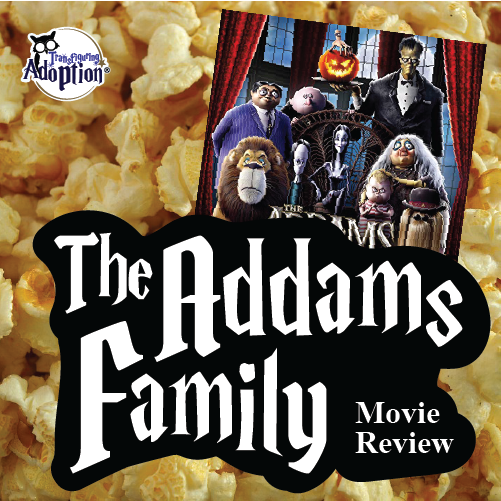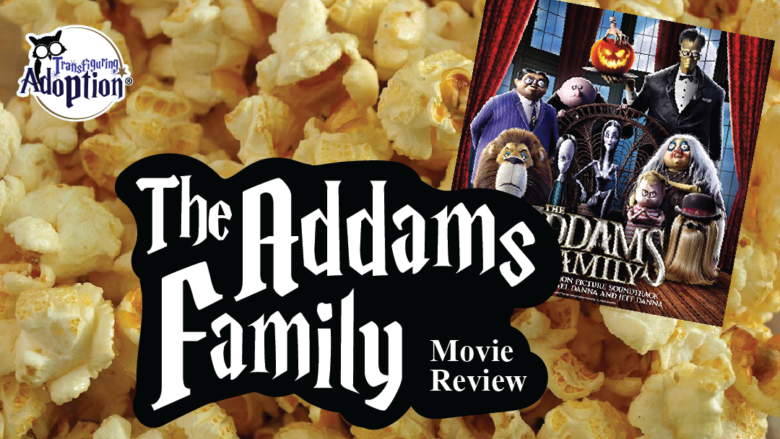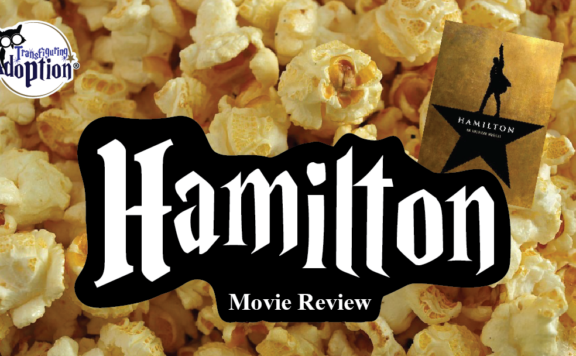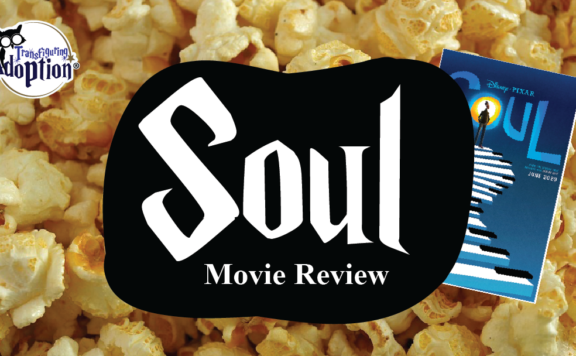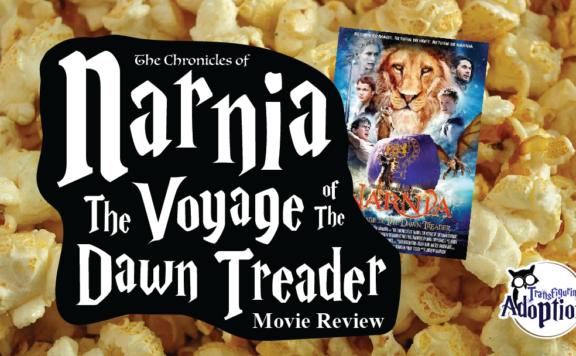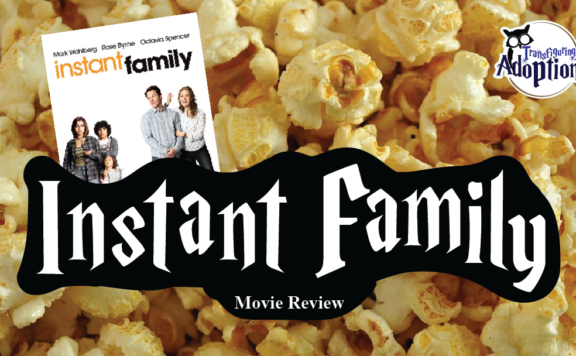Grade:
Transfiguring Adoption awarded this book 2 Hoots out of 5 based on how useful it will be for a foster/adoptive family. [Learn more about our Hoot grading system here]
Movie Info:
- Rating: PG (for macabre and suggestive humor, and some action)
- Genre: Animation, Comedy
- Runtime: 87 minutes
- Studio: United Artists Releasing & Universal Pictures
From the Cover of The Addams Family (2019) by Universal Pictures:
“Get ready to snap your fingers! The first family of Halloween, the Addams Family, is back on the big screen in the first animated comedy about the kookiest family on the block. Funny, outlandish, and completely iconic, the Addams Family redefines what it means to be a good neighbor.”
Transfiguring Adoption’s Overview:
The Addams Family (2019) is the latest of several throwbacks that have received make overs (or make unders) to draw in a younger audience. While the vocal ensemble (including Oscar Isaac, Charlize Theron, Chloe Grace Moretz, Finn Wolfhard, Nick Kroll, Bette Middler, Allison Janney, and even Snoop Dogg) does a great job with their characters and the soundtrack details are fantastic (thanks to Lurch and Thing), fans of the movies from the 1990s will notice that this is a very different Addams family from the one we knew before. While most families may laugh at some comedic jabs and cartoon violence sequences, caregivers of foster and adoptive youth should be aware that this film has some elements that could potentially be highly triggering to children that have dealt with traumas related to violent or supernatural/spiritual events.
** Spoilers Could Be Ahead **
How Is This Relevant To Adoption & Foster Care?
While none of the characters are noted to be adopted or in foster care, there are a few themes that foster youth may relate to upon viewing The Addams Family (2019). The Addams are seen as “weird” and different by their neighbors, and rumors certainly don’t help their attempts to connect with the residents of Assimilation. Beyond the weirdness and kooky shenanigans though is a family that has embedded protective factors into family traditions due to familial traumas that, suddenly, make the Addams family much less zany than they seem. This is certainly the heart of the disconnect several of our foster and adoptive children endure daily whether in school or in the caregivers home. Our children all have needs they desperately want to communicate to connect with us, but often we fail to identify their needs due to not speaking the “same language”. Trauma causes children to form their own language to survive the events that lead them to removal and then placement into the caregivers home, and expecting them to forget this language overnight can be highly unrealistic, if not impossible. Though there are many scenes that caregivers should give caution to due to violent, morbid, and suggestive themes, The Addams Family (2019) can be enjoyed by families with older children and teens with discussion after to check-in and ensure the caregiver is able to meet any unseen needs following the viewing of the film.
Discussion Points:
- Traditions and Cultural Awareness
As the Addams family has been in previous medias, the family is still creepy, kooky, mysterious, and ooky. But, as we learn through the events of the film, what the neighbors of Assimilation see as bizarre and gruesome (such as the acts of violence and the Mazurka) are actually traditions formed over several generations of Addams. The film can be a great talking piece to discuss how culture can be so multifaceted and make every family unique in its traditions and customs. - Survival Behaviors
We learn from the beginning of the film that the Addams are secluded and so focused on self-defense due to generations of experiences where the Addams were considered monsters and hunted down violently. Often when foster and adoptive children arrive in foster homes there are behaviors children may display that had significant meaning and use in the home of origin, which leads to chaos in the foster or adoptive home. This is because the children have learned ways to survive their environments to create a sense of felt safety, which is very different from a caregiver’s idea of safety. Caregivers should strive to become trauma informed to use training and knowledge to “decode” these behaviors to see what need the child is actually communicating, just as the Addams engage in constant self-defense lessons to create self-reliance and felt safety. - Creating Normalcy for Foster Children
Throughout the film it is pointed out that Wednesday is very different from her classmates and peers as a result of her isolation at Addams Manor. This includes when others call Wednesday weird for not having a cell phone and how she dresses. When Wednesday tries to branch out and test age-appropriate boundaries, Morticia struggles with Wednesday’s desire for self-exploration and social connectedness which are very typical and normal for children. This is a great discussion point to use to discuss with your children if there are areas in which they perhaps are missing out because of the stigma of being “the foster kid” and having more restrictions than the average child. - Flexible Expectations for Children
Throughout the film Wednesday and Pugsley are each shown to struggle under the weight of their parents’ expectations. However, we learn that once Morticia and Gomez learn to loosen the reigns a bit on their expectations and allow Wednesday and Pugsley to each express themselves and their talents in their own way they find more successful and happy children. Often times parents (not just caregivers) become so focused on keeping our children from failing we forget that mistakes can be learning experiences used to create teachable moments. Parents also can forget that children are going to grow into their own unique person and may not be on the same timetable as a peer or sibling. The film features plot points that can be beneficial in discussing having flexible expectations for children so that they can thrive in multiple environments, including school and the home.
Cautionary Points:
- Lots of Violence, Often Towards Caregivers and Children
Throughout the film Pugsley and Wednesday are encouraged to attack on another and their parents with intent to kill. While this plot point does have a purpose (as we learn this relates to preparing the children to protect themselves from those that mean harm), this specifically may be problematic for children and youth from the foster care system that struggle with violent and aggressive behaviors towards other children and caregivers. While some weaponry is over-exaggerated and not likely for a child to use (i.e. – grenades/bombs, land mines, guillotines, electric chairs, swords, an enchanted tree, flaming cannonballs and trebuchets, axes, dental tools, rockets, crossbows, etc.) this still doesn’t mean a child might try to utilize household tools to recreate some scenes. There are also several scenes that involve fire setting and a spirit attempting to behead Morticia with a closing window. - Gruesome and Grisly Details
This ranges from Lurch being introduced as an escapee from a mental hospital for the criminally insane (the building of which, of course, becomes the Addams’ home) to Morticia applying her parents’ ashes as blush and eyeshadow while stapling piercings onto herself. Some of these details may fly over smaller children’s heads, but Wednesday having a life-sized guillotine over her bed, a working electric chair in her room, and hair braided into nooses is more morbid than kooky. The jabs at historical mental health treatment (i.e. – a bedroom featuring a mattress-lining, use of straight-jackets, the family residing in a mental hospital for the criminally insane, etc.) are highly stigmatizing and could be problematic for children in foster care since mental health is often a focus in most treatment and permanency plans. Parents with concerns with supernatural themes should also not that there is a scene where Morticia holds a séance and tea party (intended for bonding with Wednesday) and utilizes a crystal ball and Ouija board as a telephone to speak to her deceased parents. There is also a scene where Wednesday resurrects frogs in school meant for a biology class dissection that spooked the kids in the theater in which I viewed the movie. - Dangerous Stunts
Throughout the movie Wednesday and Pugsley are encouraged to engage in violent and high risk stunts that children could try to emulate. The themes in the violence section are only the start of the actions as there are also scenes of Pugsley climbing into a lion’s mouth, sword swallowing, Pugsley being buried alive by Wednesday, Pugsley climbing a wall and shuffling around like a demonic insect, and using a sword to trim facial hair on Pugsley. - Elements Related to Bullying and Voyeurism
The film features this in a traditional sense with a mean girl bullying Wednesday and Parker in school, but there are some scenes that related to adult bullies as well. The beginning of the film features Gomez, Morticia, and the extended Addams family fighting and escaping from angry villagers that call them “monsters” and try to kill them with swords, crossbows, torches, and flaming cannonballs shot with trebuchets. In addition, throughout the film Margeaux is shown spying on every resident in Assimilation and using a social media platform to spread rumors, bully, and turn the community on those she dislikes (including the Addams family). This may be problematic for children sensitive to bullying elements and with poor cyber-safety/social media history. - Suggestive and Inappropriate Themes
Thing is seen scrolling through pictures of centerfold-styled feet, implying porn and “foot fetishes”. There are also concerning scenes with Wednesday discussing being “cage schooled” and Wednesday and Parker being locked in an attic, which has some abusive undertones. There are also some references to Stephen King’s IT including a red balloon floating around towards Wednesday, Morticia commenting that a clown should be attached to it, a clown popping up, and other references. If for whatever reason no one has said so, do NOT allow your children to watch It, please!!, but if your child or youth has viewed this or heard about the grisly details from that movie from friend these references may be problematic and induce nightmares. - Representation of an Inattentive Parent
Margeaux is shown throughout the film to ignore Parker in favor of her show’s ratings. Margeaux also is seen speaking harshly to children and calls Wednesday a “creep”. Parker shows open frustration with her mother and at one point even states, “I knew I should have moved in with my dad.” This may invoke some deep feelings for children in foster care that struggle with relationships with biological parents. - Car Accident Scene
Before discovering Lurch, the Addams are in a car accident caused by the driver being distracted by the radio and driving fast in the fog. This results in a car crash where the car hits Lurch, who is bound in a straight-jacket in the middle of the road. - Survival Behaviors Shown
Some of these behaviors come from the children, such as Wednesday running away from home and both children acting out violently. There are also scenes where adults are encouraging of certain behaviors that children in foster care sometimes develop due to extraordinary events that they are trying to unlearn in a caregiver’s home. This can include Grandmama bragging about gambling and robbing Somalian pirates. She excuses cheating in gambling by saying “it ain’t cheating if no one catches you.” - Phobia-Related Triggers
There are references to clowns due to the movie “It”. There is also a scene where Morticia “surfs the web” by crossing a bridge of moving spiders. There are also several scenes depicting the household spirit trying to kill members of the Addams family in the home. There is also an enchanted tree that reacts violently to intruders.
Discussion Guide:
- Why did the Addams have so much time dedicated to practicing fighting and traps?
Caregiver Note: Before discussing behaviors, it’s good to look at the root of where a behavior came from. Children (and many adults) often do not see the connection between events, feelings, and then a behavior that responds to the events and feelings. Caregivers working with children that have endured trauma need to become experts in this connection to help children become self-aware of their feelings leading to behaviors. - While the fighting and traps were useful in escaping the angry mob in the village, were they useful in making friends with the neighbors in Assimilation? Why or why not?
Caregiver Note: Though the behaviors children develop in response to trauma certainly helped them survive up until this point, the same behaviors can cause chaos in the caregiver’s home and in school due to the reasons for these behaviors being removed. Children may continue to tell lies in a caregivers home because in the past telling the truth meant being punished horrifically, and this will take come practice, time, and patience to practice truth telling and honesty especially in times of stress. This is because cognitive functioning decreases in times of emotional escalation, meaning children are more likely to rely on poor coping mechanisms in times of great stress because it is what they know best and are most comfortable with. Caregivers should be mindful of this when practicing new skills with the foster or adoptive child. - How did Wednesday stand out in her new school compared to her classmates?
Caregiver Note: It’s important to emphasize with this that Wednesday is not “bad” or “weird” for being different from her peers, but that she is unique. Help your child if they struggle with differences. Differences can include how she talks, how she dresses, her interests, not having a cell phone, and being homeschooled prior. - When Wednesday was trying to find styles and interests for herself, how could Morticia have helped? Though Morticia meant well, what was not so helpful while Wednesday was exploring new things?
Caregiver Note: Sometimes caregivers need to remember that our children are unique individuals that are going to forge their own paths someday. Sometimes these paths may mirror what we hope for them, but sometimes our children may be destined for a path very different from the one we traveled. As long as our children are entering adulthood happy, healthy, and with a bit of direction caregivers need to remember to hold their own hopes and dreams loosely to allow our children room to find that path, which us helping along the way. Wednesday probably would have benefitted from Morticia listening to her about what she needed, giving some (appropriate) space for self-exploration (i.e. – making friends, clothing style, interests, having a means to connect to peers like a phone, etc.), and supporting Wednesday’s new interests. Less helpful actions could include Morticia keeping Wednesday from her friends, tightening her grip on things Wednesday could explore and control, and trying to force Wednesday to exclusively participate in her own interests. - Activity: Create a Family Theme Song MadlibsCaregiver Note: Work with your children to create a family theme song, madlibs-style! When you are done, find an instrumental version on Youtube to deliver the theme song with snaps and all. This will not only allow for bonding through giggles and fun but will also allow for some grammar practice.
Here is an example:
The ___________ Family
They’re _____________(adj.) and they’re _____________(adj.),
_____________(adj.) and ______________(adj.),
They’re altogether ______________(adj.).
The __________ family!
Their house is a _______________(noun)
Where people come to ______________(verb) ‘em
They really are a _______________(noun)
The __________ family!
_____________(adj.) , ______________(adj.), _______________(adj.)
So get a _________________(possessive noun) _________(noun) on
A ______________(noun) you can __________(verb) on
We’re gonna _____________(verb) a _______________(noun) on
The ___________ Family!
- Why was Gomez so focused on the Mazurka? Why was Pugsley disinterested in practicing for the Mazurka?Caregiver Note: Much like the conflict between Morticia and Wednesday, Gomez is putting an increased amount of expectations on Pugsley without considering if this is what Pugsley wants. Gomez is excited as he culturally sees this as a right-of-passage to his son and has personal pride from his own Mazurka experience at stake. However, Pugsley is more interested in explosives than swords and can be seen self-sabotaging in refusing to practice and hiding further in the interests in explosives
- Why was Pugsley afraid of talking to Gomez about the Mazurka?Caregiver Note: Just like Pugsley, even though our children may not share our own passions and dreams they can be hesitant to share these feelings in fear of disappointing a beloved caregiver and, therefore, ruining that relationship. Caregivers need to note that this is especially true of children that have suffered trauma due to loss and separation from primary attachments such as biological parents. Caregivers need to take note to watch how they talk about expectations and ensure that the child is not overwhelmed by fears of disappointing you or other meaningful adults in their lives if they wish to pursue different interests or perhaps adjust a tradition. And remember, Gomez was not trying to be hurtful or pushy with his insistence but that Pugsley’s fear of disappointment was still very real and very meaningful
- How did Pugsley use his talent to make the Mazurka his own?Caregiver Note: Pugsley failed his first Mazurka due to not having much talent or interest in swordsmanship like his father, Gomez. The entire time Pugsley was visibly uncomfortable and, at times, afraid. However, once he was allowed to perform the Mazurka with his rockets and explosives, Pugsley was the star of the night and even used these gifts to safe his family… which was the heart of why the Mazurka became a tradition! Caregivers should note that sometimes traditions can change a little in practice but still have just as much meaning and heart to that custom/tradition. For example, if trimming a tree important for you during the holidays but a child’s allergies restrict a live tree an artificial tree will still provide the means to spend time together making and assembling decorations as a family with fun and bonding. Think about ways perhaps a tradition may become your own with your children to create meaningful memories together.
- What are the things you are interested in doing? How can I help you like Gomez helps Pugsley?Caregiver Note: Once the communication barriers between Wednesday and Mortica and Pugsley and Gomez have been discussed, this may make it a little easier to discuss how you can meet the needs of your child. There may still be some things a caregiver cannot promise or guarantee (i.e. – court orders, safety plans, etc.) but caregivers should strive to avoid saying no outright. Hear your child out, brainstorm together about possible solutions, and if something as stated is not feasible consider making it a “yes, but…” to put conditions in place. Often foster and adoptive children are told “no” so much by courts, workers, and foster parent requirements that the word can trigger an angry or escalated response. Meeting a request with a conditional yes, options, or even an understanding ear can make a world of a different to a child that seldom has choice. This also allows for you as the caregiver to make accommodations and adjustments to expectations based on your child’s ability and need.
- Activity: Water-Balloon Bomb
Caregiver Note: This activity is encouraged during a warmer season and to be conducted outdoors. Designate one Gomez (aka, the target) with a fake mustache. The object of the game is for all the Pugsleys (or Wednesdays if the children prefer) as a team to pop 10 water balloons on Gomez within two minutes. Gomez may defend against the “bombs” with a sword-sized stick by swatting them away. Everyone can take turns being Gomez with their own fake mustache.
About the Author: Rachael Rathe
Rachael B. Rathe is an East Tennessee native with a Bachelor of Arts Degree in Psychology with a Minor in Child & Family Studies from The University of Tennessee Knoxville. She has worked in mental health since 2013 and in foster care/adoptions for a private provider agency since 2014. Rachael was inspired to work in the field after working with children and teens on a volunteer basis 2008 – 2013. Rachael’s ideal self-care day involves snuggling on a couch with her kitties (Tabitha, Fergus, and Rufus) while enjoying a good movie or book. She also enjoys galavanting around conventions concerning all things nerd and geekery.
**Transfiguring Adoption is a nonprofit organization seeking to nurture growth in foster and adoptive families by giving a HOOT about their families. Transfiguring Adoption does not intend for its reviewers nor its review to be professional, medical or legal advice. These reviews and discussion guides are intended to help parents to better be able to connect and understand their children who come from traumatic backgrounds.